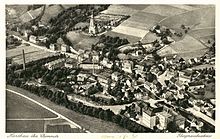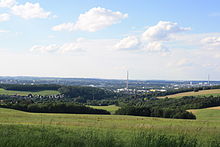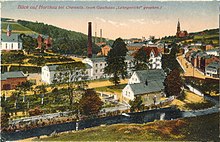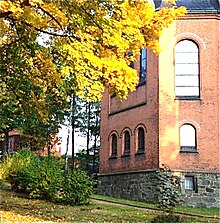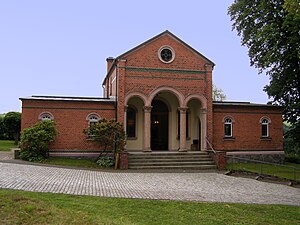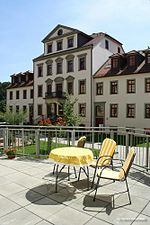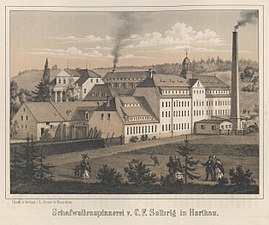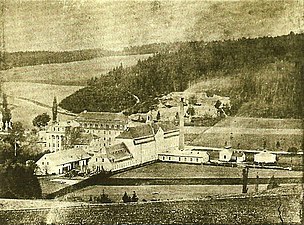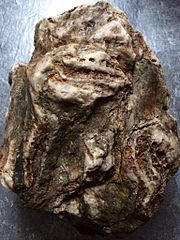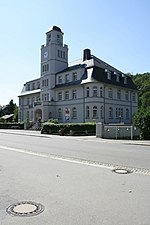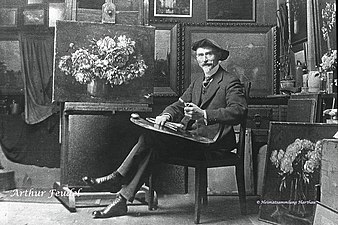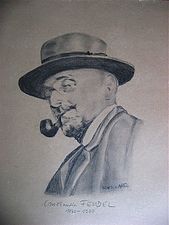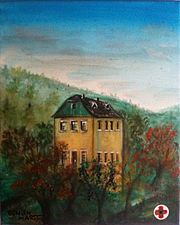Chemnitz-Harthau
|
Harthau district and statistical district No. 45 of Chemnitz |
|
|---|---|
| Coordinates | 50 ° 46 '37 " N , 12 ° 55' 34" E |
| surface | 6.30 km² |
| Residents | 2372 (Dec. 31, 2013) |
| Population density | 377 inhabitants / km² |
| Incorporation | Jul 1, 1950 |
| Post Code | 09123, 09125 |
| prefix | 0371 |
| Transport links | |
| Federal road |
|
| tram | C11 (old 522) |
Harthau is a southern district of Chemnitz , which borders the districts of Altchemnitz , Erfenschlag , Klaffenbach , Einsiedel and Markersdorf . It extends between the Harthwald and Pfarrhübel along the lower reaches of the Würschnitz and the B 95 to Annaberg-Buchholz up to the Harthauer Berg. In the north, Harthau extends to the confluence of the Zwönitz and Würschnitz rivers to the Chemnitz .
history
There are no written sources about the beginning of the settlement, but it began before 1340, because the first document is available from this year, a feudal letter, which documents the change of ownership of the Harthauer feudal court. The name Harthau means "place in the mountain forest", it is derived from the names "Harth" and "Wartha". It is assumed that the place was a small forest hoof village from these two submerged desolations around the 12th / 13th centuries. Century. The Harth desert was probably located on the hill between the Alte Harth and Einsiedel , the location of the Wartha desert is undetermined. Both of these deserted areas were abandoned due to the poor soil conditions and the lack of water and relocated to the Würschnitz valley .
Harthau was owned by the Chemnitz Benedictine monastery . The number of inhabitants is recorded in a register of the monastery, so 1486 13 resident and 1537 14 resident and 9 non-resident families are registered. The monastery operated a cutting mill in Harthau. In the course of the secularization of the monastery, Harthau became an official village in 1548, since 1856 it belonged to the court office, in 1875 to the administrative administration, later to the district and from 1950 to the city of Chemnitz.
From the comparison of the population of 1548 with 17 "possessed men", 2 "cottagers" and 27 inhabitants with those of 1765 with 13 "possessed men", 1 gardener and 15 cottagers it can be deduced that the Thirty Years ' and Seven Years' War left their mark to have. The medieval ban mileage law did not allow any craftsmen in the Chemnitz area. It was not until the Grimma Treaty of 1555 that master craftsmen could be admitted to the villages. In Harthau there was a linen weaver, a tailor and a cooper.
The first mining attempts were made in Harthau as early as 1422. Excavations for copper were carried out in 1708, with little success. Attempts to drill hard coal around 1819–1848 were also unsuccessful.
With the establishment of the spinning mill by CF Bernhardt in 1798, Harthau became the starting point for the industrial revolution in Saxony. In 1803 114 men, women and children were employed here. The Bernhardsche spinning mill was known far beyond Saxony. Even JW v. Goethe visited the spinning mill in 1810. An important branch of industry in Harthau was also stocking knitting . In 1857, 157 masters, 80 journeymen and 36 apprentices belonged to this guild. Harthau developed more and more into an industrial location. Around 1875 there were two spinning mills (Sächsische worsted yarn spinning mill and worsted yarn spinning mill Schäfer), a cassette and copying press factory (Drechsler & Wagner), two iron foundries (Gebr. Richter and Gebr. Steiner), a cotton wool factory (Schubert) and 10 other smaller companies .
The population increased continuously. The municipality had the following inhabitants:
| Population development | |
|---|---|
| Year / date | Residents |
| 1834 | 1.106 |
| 1849 | 1,300 |
| 1871 | 1,629 |
| 1880 | 1,764 |
| 1890 | 2,688 |
| 1900 | 4,503 |
| 1910 | 6,484 |
| 1925 | 6,842 |
| 1933 | 7.139 |
The population growth is also due to the fact that many Chemnitz workers chose the beautifully situated town of Harthau as their place of residence. A new district was created on the left bank of Würschnitz. The worsted spinning mill built Wohnhäusel 'for employees on Klaffenbacher Strasse (part of it was incorporated into the Klaffenbach community in 1938). Further apartments were built in Alte Harth and on Richterberg.
With the enlargement of the municipality, the municipal political tasks and decisions also increased. In 1838 the municipal council and the municipality board were created, which did their work on a part-time basis. Until 1874, the respective feudal court owner exercised police power. From 1924 onwards, the municipality board acted as a full-time mayor. The municipal council met in the apartment of the respective municipal council until the municipal office was established in the previous schoolhouse in 1890. The current town hall was built in 1913.
As early as 1889, Harthau was the first place in the area to receive electricity from the Oswald Schubert cotton wool factory. On October 1, 1895, Harthau was connected to the state railway network with the construction of the railway line. In 1920 it was connected to the city gas network and in 1938 a water pipe was built.
In the church visit protocol of 1539 a church in Harthau is mentioned, but it existed earlier. Although this church was rebuilt and expanded several times, it was no longer sufficient for the constantly growing place. After extensive negotiations, construction of the Luther Church began in 1906, and its solemn consecration took place in August 1908. The old church has served as a memorial for the 234 fallen of the First World War since 1925 . It is a listed building and is used today for festive music events. In 1904 the new cemetery and in 1905 the cemetery chapel were handed over.
The economic and social changes also affected the school system. Until 1846 a teacher taught all students in one class in Harthau. The church school building, built in 1861, already had two classrooms and two teacher's apartments. The school building erected in 1891 was too small after only 10 years, so that the large school was inaugurated in June 1901. The gym was built in 1913. The Johanneum children's home, established as a foundation in 1855, was relocated to Harthau in 1926. The home was used as a special children's home until 1992. Since 1999 it has been expanded as a residential building.
Due to the industrialization and the associated restructuring, the Harthau population became politically active at an early stage. The Fatherland Association was founded in 1819, the Lassalleans in 1869 and the local social democratic association in 1907. In 1869 there was already a trade union association. The local group of the KPD was founded in 1919. The workers proudly called Harthau "Little Moscow".
The Second World War also had its painful effects on Harthau. On February 14 and March 5, 1945, 39 buildings were totally destroyed, 27 severely and 39 moderately or slightly damaged. The community took in almost 800 refugees. The church leadership was taken over by the SPD and the CDU . Since 1919 there have been several attempts by the community to incorporate Harthaus into the city of Chemnitz. However, due to differences of opinion, no contract was reached. It was not incorporated into the city until July 1, 1950. As a result, the place lost its independence and identity.
symbolism
Blazon: Under a green stepped gable head and on a green three-hill in gold sprinkled with gold balls, a soaring red-armored and red-tongued black wolf, holding a black Benedictine cross slanted to the right.
The colors green-gold-black indicate that Harthaus belongs to the Free State of Saxony. Black and gold, on belonging to Chemnitz, the Dreiberg on its location on the northern edge of the Ore Mountains. The Benedictine cross is intended to commemorate the Benedictine monastery to which Harthau belonged in the 15th and 16th centuries. The stepped gable division is intended to create a reference to the factory buildings from the 18th and 19th centuries, which have been preserved in Harthau to this day (see → Bernhardsche Spinnerei and → Sights ). The scattered balls on a green background are reminiscent of the mining tradition . The wolf, which stands for the hunting tradition in the region, which goes back to Elector August , also picks up on regional sagas and stories.
Church history Harthau
In 1539 there was already a stone church in Harthau for the villages of Harthau, Berbisdorf and Eibenberg . The previous Romanesque building was excavated in 1966–1968. In 1609 and 1765 it was fundamentally rebuilt and still stands today as the "Old Harthauer Church" on the mountainside behind the rectory.
As a result of the construction of two spinning mills and other industrial plants in the village, the population grew to 7,000 at the beginning of the 20th century (today around 2,400). Although in 1901 Eibenberg and 1905 Berbisdorf received their own churches, the old church was no longer able to cope with the many believers. In 1906–1908 the new and larger Luther Church was built. Despite the only slight damage in World War II, the church had to be fundamentally restored in the 1980s. This happened with great commitment from the Harthau community members and local residents. The altarpiece from the church of the former village of Magdeborn has been added . In 1988 the church could be inaugurated again with a festive service.
Bernhard spinning mill
"At Hartha, in a romantic valley on the Würschnitz, is the large spinning mill of the Bernhard brothers ..."
In 1797, Carl Friedrich Bernhard bought a plot of land in Harthau to build a factory and one year later, with the help of Evan Evans and the architect Johann Traugott Lohse, built one of the first and most important mule mills on the European continent, which together with the Wöhler and Lange spinning mill on Fischweg in Furth initiated the industrial revolution in the Chemnitz area and in Saxony . Even Johann Wolfgang von Goethe visited the extremely successful spinning mill, which is considered a technical marvel in 1810. After the Wars of Liberation (1813–1815), the spinning mill went bankrupt, later it was used by Carl Gottlieb Haubold , Friedrich Georg Wieck and Carl Friedrich Solbrig , among others .
The original building from 1800, the classical manor house of the Bernhard family completed in 1807 and the former factory school building built in 1836 as a workers' residence (secured ruin) have been preserved from the ensemble of the Bernhardschen spinning mill. The founding building and mansion were renovated in 2006 after many years of dilapidation and are now used as a retirement home. The "Spinnmeisterhaus", which had been in ruins until then, was demolished in 2008.
The memorial stone for Heinrich Jacob Bernhard, the father of the Bernhard brothers who died in the manor house in 1807, was formerly located in the park of the Bernhardschen Spinnerei and is now on a reconstructed base in the cemetery of the "Old Church of Harthau". The memorial stone was recovered from the Würschnitz during construction work.
Mining in Harthau
northern edge of the Erzgebirge near Chemnitz-Harthau (river rubble from the Würschnitz )
The foothills of the Lugau-Oelsnitzer coal field reached as far as Mittelbach and Harthau .
Despite its location on the northern edge of the Ore Mountains, Harthau was never a major mining location. Mining copper began here around 1422 . In the 18th and 19th centuries, exploratory mines were built on copper, silver and hard coal , but this did not lead to the discovery of deposits that were worth building and thus to the cessation of mining activities. The preserved tunnels were converted into air raid shelters during the Second World War.
After all, was to about 1970 in a quarry " hypochlorite containing hornblende slate" degraded, a the amphibolite like, presumably from a " diabase " with large plagioclase laths ( ophitisches or porphyry structure ) product derived metamorphic rock . This dark gray-green stone with white, yellowish or reddish spots ( chlorite slate from Harthau or Harthauer Grünstein ) can be found on several representative buildings in the Chemnitz area, for example in the base of the Luther Church in Harthau.
Worth seeing
Harthaus’s busy industrial past brought extensive construction activities with it. Even today, there are several monuments of industrial history in the village, albeit mostly in poor condition, such as the factory building (1800) and the manor house (1804) of the Bernhardschen spinning mill, Saxony's first factory, as well as the factory complex (ruin) of the worsted yarn spinning mill Paul Schäfer & Co. (from 1886), Oswald Schubert's cotton wool factory (1898) or the factory owner's house (1861) and the foundry hall (1872) of Chemnitz's oldest preserved iron foundry, the Richter foundry. In addition, several residential buildings and villas from the 19th and 20th centuries that are well worth seeing have been preserved in Harthau, including the Schäfer villa estate (around 1885), the historic civil servants 'and workers' houses on Klaffenbacher Strasse opposite the spinning mill, the beautifully renovated former Harthau town hall ( 1916), the Solbrigsche Factory School on Klaffenbacher Straße, Chemnitz, the last remaining factory school building from 1836, or the former Johanneum (1926).
The small town has two churches worth seeing. In the large Luther Church, built between 1906 and 1908 according to a design by the Leipzig architect Paul Lange , the choir, which is designed with clear echoes of contemporary Art Nouveau , is particularly worth seeing. The "Old Church Harthau", a mountain church from the 17th / 18th centuries. Century, impresses with its simple architecture and its charming location. Historic hereditary burials from the Harthau factory owner dynasties have been preserved in their cemetery, including the late classicist grave complex of the Chemnitz “wool king” Carl Friedrich Solbrig. Below the old church you will find the former church school building (1861) and a Biedermeier half-timbered house (1840), a contemplative historical building ensemble.
The historic chlorite slate quarry in Harthau (opened up from 1822) on Annaberger Straße is an almost unknown attraction in Chemnitz .
There are several hiking trails around Harthau. They offer a beautiful view of the Würschnitztal and the Ore Mountains. With the Lindenhöhe (1931) and the Körnerhöhe built by the Erzgebirgsverein in 1913, you can also discover two historical viewpoints.
There are several cafés and restaurants in Harthau, including the historic “Waldhaus” restaurant in the “Alte Harth” district.
sports clubs
The sports club Chemnitz / Harthau e. V. emerged in 1990 from the "BSG Progress South" founded in 1946 as a suburban association in Altchemnitz / Harthau. The association has around 180 members who regularly play sports in the three departments handball, volleyball and recreational sports.
Events
In Chemnitz-Harthau, the school and home festival takes place once a year, usually in June. In addition to an exhibition of the Harthau home collection with changing themes on the history of the site, a demonstration of the Harthaus carving tradition and performances on the stage in front of the Harthaus primary school are program items of the school and home festival. The highlight of the festival is the screening of a historical film about Harthau from the 1920s Years.
The “Old Church Harthau”, now an event center after the restoration, offers various public events such as concerts, readings and film screenings throughout the year.
At Christmas time, the nativity play is performed in the Luther Church in Harthau.
The “Alte Wanne” youth club and the Harthau parish offer various events for their respective target groups throughout the year.
traffic
In 1895 the railway line from Chemnitz to Stollberg was put into operation as a new part of the Würschnitztalbahn , which runs through Harthau and crosses the only railway tunnel in Chemnitz. After electrification, the route has been used by Chemnitz Stadtbahn vehicles since December 15, 2002 , which is owned by City-Bahn Chemnitz . Since then, the railway has stopped at the "Chemnitz-Harthau" stop, as well as at the "Chemnitz-Riemenschneiderstraße" and "Chemnitz-Friedrichstraße" stops.
Personalities
The two painters Arthur and Constantin Feudel were born in Harthau . Both were best known in the Netherlands and New York as well as in Italy and Dresden - but in Chemnitz they are almost forgotten. On the occasion of their 150th birthdays in 2007 and 2010, Arthur and Constantin Feudel were honored with exhibitions in Harthau.
Another important son of Harthaus is the actor Dieter Franke , who won the sympathy of a wide audience at the Deutsches Theater and in numerous film and television roles with his comedically designed characters.
literature
- Richard Steche : Harthau . In: Descriptive representation of the older architectural and art monuments of the Kingdom of Saxony. 7th issue: Amtshauptmannschaft Chemnitz . CC Meinhold, Dresden 1886, p. 43.
Individual evidence
- ↑ a b our Harthau. In: HARTHAU, southern part of Chemnitz. Harthau home collection, accessed on July 19, 2010 .
- ↑ Alexander Jacob: Family coat of arms, heraldry and heraldic art, 2010-2014. Volume 3, Format Druckerei & Verlagsgesellschaft mbH, Jena 2014, ISBN 978-3-944829-12-8 , p. 11
- ↑ Luther Church Parish Harthau. Retrieved July 19, 2010 .
- ↑ Hartha, Harthau . In: August Schumann : Complete State, Post and Newspaper Lexicon of Saxony. 3rd volume. Schumann, Zwickau 1816, pp. 697-699.
- ^ Stadtbuch Chemnitz, edition 4/2011, WochenSpiegel Sachsen verlag GmbH Chemnitz, "District Harthau" p. 95
- ^ Hermann Credner (Red.): Explanations of the special geological map of the Kingdom of Saxony. Sheet 114: Burkhardtsdorf. By T. Siegert & F. Schalch, et al., 2nd ed., Revised. by E. Danzig. Leipzig 1914, p. 21 ( online at SLUB-dresden.de)
- ^ O. Herrmann: Quarry industry and quarry geology . Berlin 1899, pp. 271-272.
- ^ Chemnitz in the early 19th century (in: Denkmalgalerien). (No longer available online.) In: baudenkmäler-chemnitz.de. Sandro Schmalfuß, archived from the original on August 8, 2010 ; Retrieved July 19, 2010 . Info: The archive link was inserted automatically and has not yet been checked. Please check the original and archive link according to the instructions and then remove this notice.
- ↑ Home collection. In: HARTHAU, southern part of Chemnitz. Harthau home collection, accessed on July 19, 2010 .
Web links
- Harthau in the Digital Historical Directory of Saxony
- Harthau home collection
- Harthauer Rundschau (private blog)


